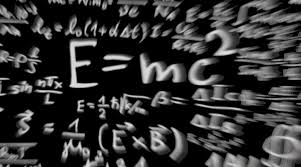
In physics, mass–energy
equivalence is a concept formulated by Albert Einstein that
explains the relationship between mass and energy. It
states every mass has an energy equivalent and vice versa—expressed using the
formula
E = mc2
where E is the energy
of a physical system, m is the mass
of the system, and c is the speed of light in
a vacuum (about 3×108 m/s).
In words, energy equals mass multiplied by the speed of light squared. Because
the speed of light is a very large number in everyday units, the formula
implies that any small amount of matter contains a very large amount of energy.
Some of this energy may be released as heat and light by chemical or nuclear
transformations. This also serves to convert units of mass to units of energy, no matter what system of measurement units used.
Mass–energy
equivalence arose originally from special relativity as a paradox described
by Henri Poincaré. Einstein proposed it in
1905, in the paper Does the inertia of a body depend upon its
energy-content?, one of his Annus Mirabilis ("Miraculous
Year") Papers. Einstein was the first to propose that the equivalence
of mass and energy is a general principle and a consequence of the symmetries.
A consequence of
the mass–energy equivalence is that if a body is stationary, it still has some
internal or intrinsic energy, called its rest. Rest mass and rest energy are
equivalent and remain proportional to one another. When the body is in motion
(relative to an observer), its total energy is greater than its rest energy.
The rest mass (or rest energy) remains an important quantity in this case because
it remains the same regardless of this motion, even for the extreme speeds or
gravity considered in special and general relativity; thus it is also called
the invariant mass.